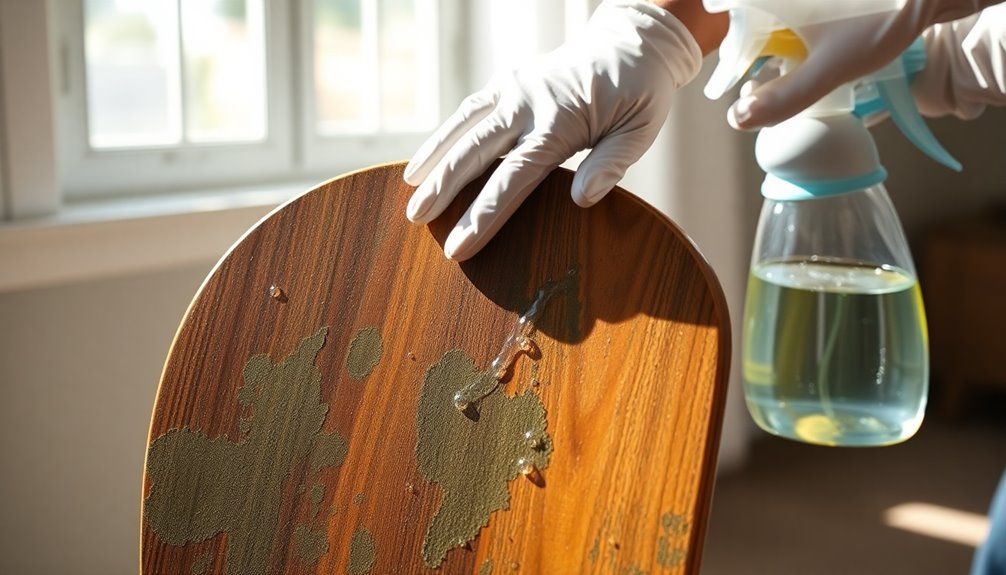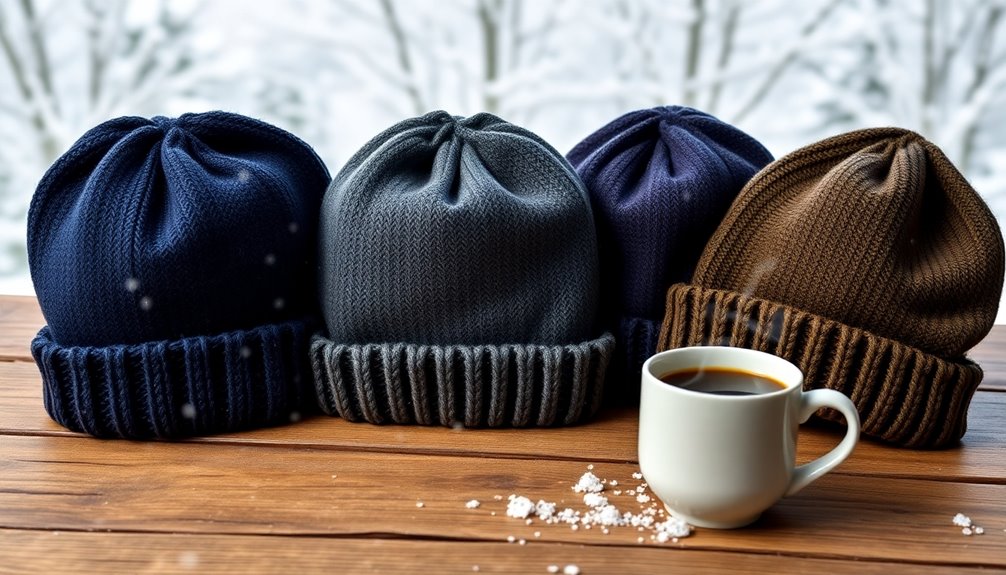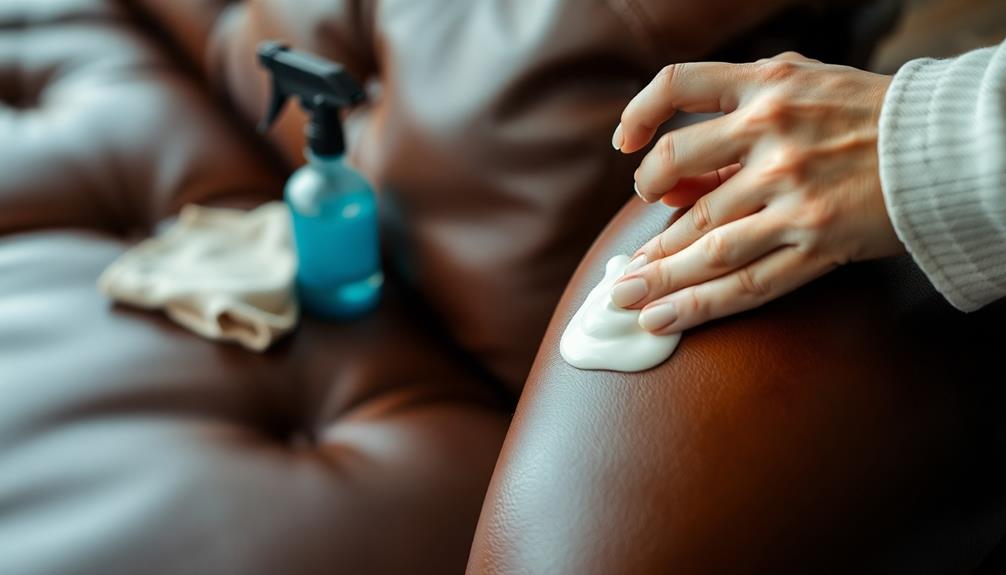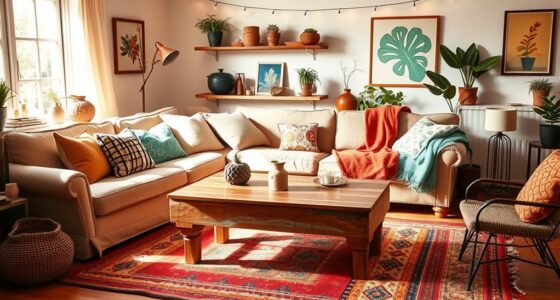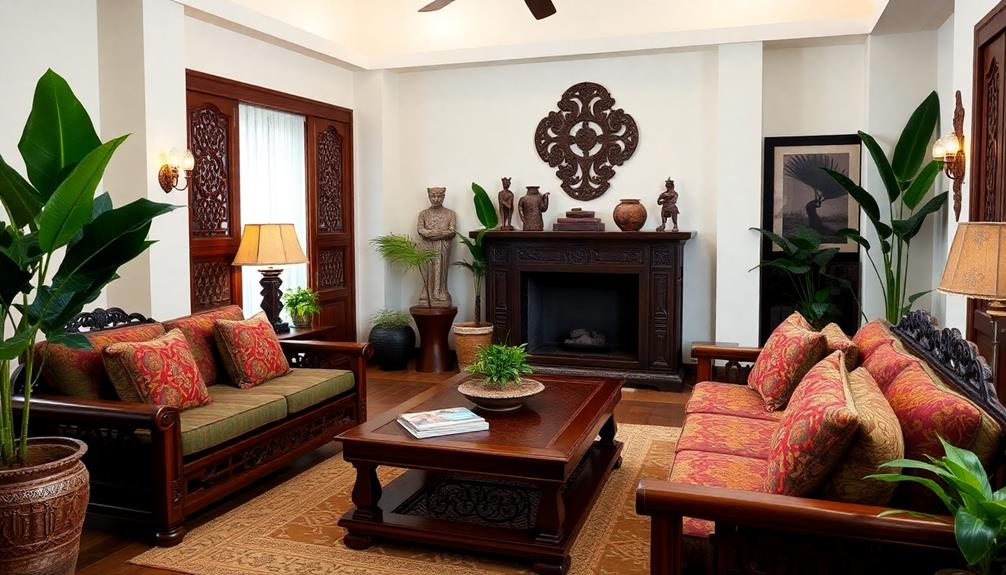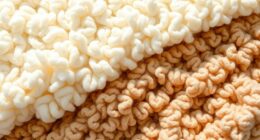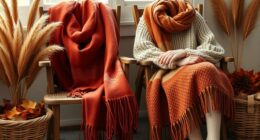To remove mold from furniture, first, identify the affected areas by looking for fuzzy patches or a musty smell. Put on protective gear like gloves and a mask, then clean with a vinegar solution (equal parts vinegar and water) or a hydrogen peroxide solution for stubborn stains. For fabric furniture, gently scrub the moldy spots, rinse, and let it air dry in sunlight. For wood, ensure the surface dries completely after cleaning. Maintain low humidity and proper ventilation to prevent future growth. If you want more detailed tips on tackling mold effectively, there's plenty more to uncover.
Key Takeaways
- Identify mold presence by checking for fuzzy patches, musty smells, and damp areas; gather protective gear before cleaning.
- Use a vinegar solution or hydrogen peroxide for cleaning moldy spots, ensuring the fabric is compatible with the chosen solution.
- Vacuum moldy areas with a HEPA filter vacuum and dispose of the vacuum bag immediately to prevent spore spread.
- Air dry cleaned furniture in a sunny, well-ventilated area to prevent future mold growth.
- Maintain humidity levels between 30%-50% and regularly inspect for moisture to prevent mold reoccurrence.
Identification and Preparation
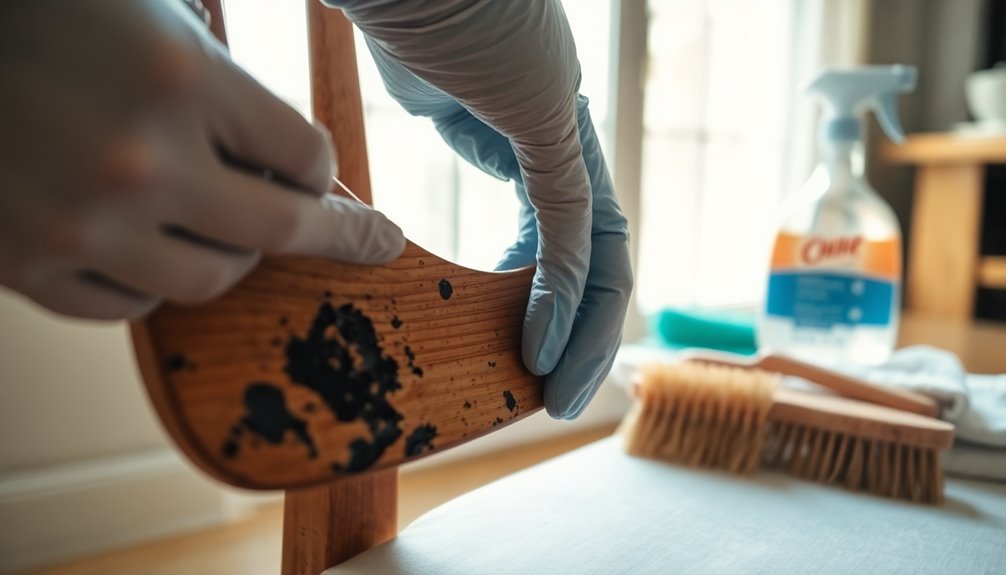
Identifying mold on furniture is crucial for effective removal and prevention. You should start by looking for visual signs like fuzzy, slimy, or discolored patches, which can appear in colors such as black, green, white, or orange. Circular patterns might indicate mold colonies, and the texture can be suede-like or velvety. Don't forget to check for warped or buckled wood surfaces.
Next, pay attention to odor and moisture. A musty smell often signals mold presence, so look for damp areas or signs of water damage. Environments with excessive moisture and poor ventilation are prime spots for mold growth. It's also important to remember that hidden mold can still be present even if not visible.
Familiarize yourself with common mold types. Black mold has a slimy, greenish-black appearance, while Aspergillus may appear gray, white, green, or black. Penicillium shows bluish-green or white coloration, and Alternaria can be dark green or brown.
Before you start removing mold, gather protective gear like gloves, safety goggles, and a HEPA filter mask. Proper ventilation's key, so ensure the area is well-aired. With these preparations, you'll be ready to tackle mold effectively and safely.
Cleaning Solutions
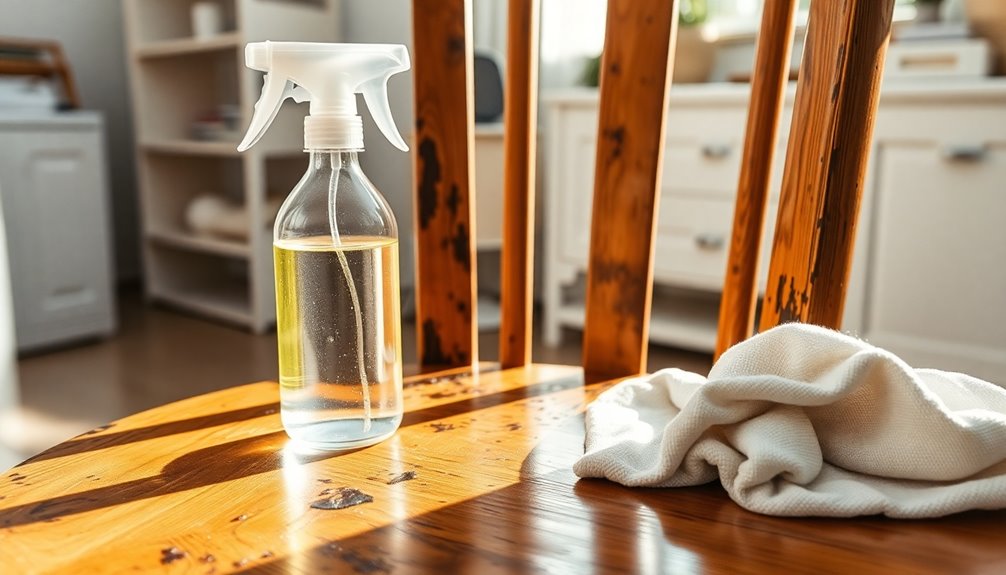
When it comes to effectively removing mold from furniture, you have several powerful cleaning solutions at your disposal. One of the simplest is a white vinegar solution. Mix equal parts of water and white vinegar; it acts as a natural disinfectant and is safe for most fabrics. You can leave the area to air dry for added mold prevention.
For stubborn mold stains, consider using hydrogen peroxide. A 3% solution applied directly to the stains can be quite effective. Just make sure the fabric dries completely afterward to avoid damage. Black mold is a serious health threat and should be handled with care if you suspect it is present.
Isopropyl alcohol is another strong option. Mix one part alcohol (at least 70%) with one part water. This quickly evaporating solution is safe for most upholstery and helps disinfect the area.
If you prefer natural remedies, try a baking soda paste made from baking soda and water for spot cleaning. You can also use diluted tea tree oil, which has natural fungicidal properties.
Lastly, commercial mold removers like Mold Armor or Concrobium can be effective when applied according to manufacturer instructions. Just make sure they’re suitable for your furniture’s fabric type before use. Additionally, when using commercial mold removers, it’s important to wear protective gear, such as gloves and masks, to avoid any potential health risks. If you’re dealing with other types of stains, knowing how to clean nail polish stains can also be beneficial, as it can save your furniture from permanent damage. Always test any solution on a small, inconspicuous area first to ensure it doesn’t adversely affect the fabric.
Safety Precautions
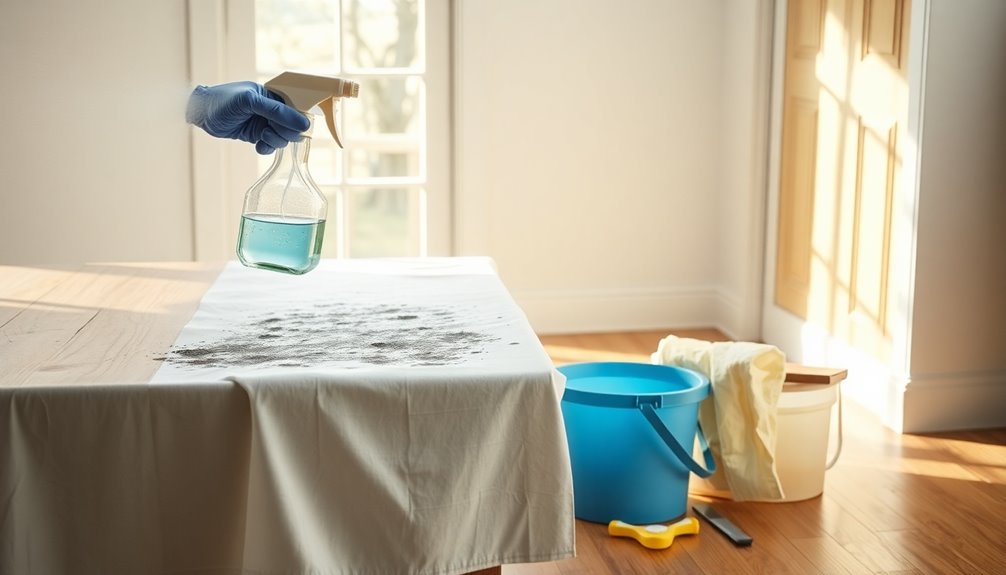
Taking safety precautions is crucial when removing mold from furniture to protect yourself from potential health risks. Start by wearing nitrile gloves to prevent skin contact with mold and use protective eyewear, like safety goggles, to shield your eyes from spores and debris. It's important to wear a half-face respirator or a mask with a HEPA filter to avoid inhaling harmful mold spores. Consider donning a disposable protective suit to keep your skin and clothing safe.
Ensure the area is well-ventilated by opening windows and doors, which helps prevent the accumulation of fumes and spores. Isolate the cleanup zone to keep unprotected individuals away and to contain any mold spread. Avoid running any HVAC system that might be contaminated, as this can disperse spores further. Regular checks for moisture and mold in your living spaces are also essential to prevent extensive damage during the cleanup process.
Be cautious when cleaning behind wallpaper, as this can release spores into the air. Always bag, seal, and properly dispose of any damaged materials. Finally, remember to maintain good airflow after cleaning to help surfaces dry completely and prevent new mold growth. Following these safety measures will help you effectively tackle mold while keeping yourself safe.
Cleaning Fabric Furniture
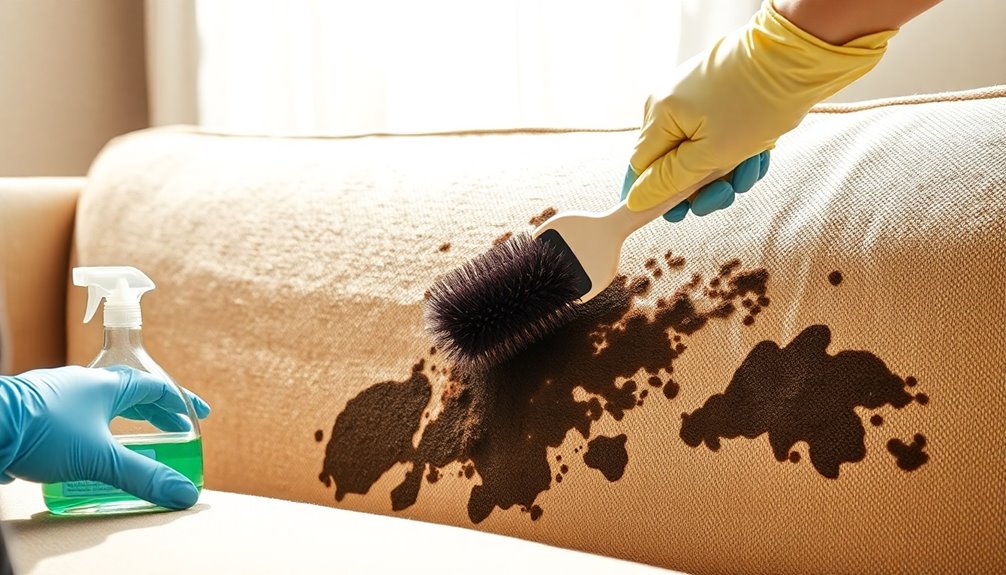
How can you effectively clean mold from fabric furniture? Start by assessing the fabric type to ensure it can handle your chosen cleaning solution. If it's safe, vacuum the moldy areas using a HEPA filter vacuum to remove spores. Discard the vacuum bag right after to avoid spreading the spores elsewhere.
Next, consider using a cleaning solution. A vinegar solution is a great option; mix equal parts white vinegar and water in a spray bottle. Spray it liberally on the moldy spots and let it sit for about an hour. After that, gently scrub with a soft brush or cloth and rinse with clean water. Alternatively, you can use a 3% hydrogen peroxide solution in the same manner. Remember to be mindful of high humidity levels, as they can contribute to mold growth. Maintaining a good air quality can also help prevent mold spores from settling.
If the fabric can tolerate bleach, mix 1/2 cup of bleach with 1 quart of water, apply it sparingly, and rinse thoroughly after 15 minutes. Always make sure not to oversaturate the fabric, as this can cause damage. Finally, allow the fabric to air dry completely in a sunny, well-ventilated area to prevent future mold growth.
Cleaning Wood Furniture
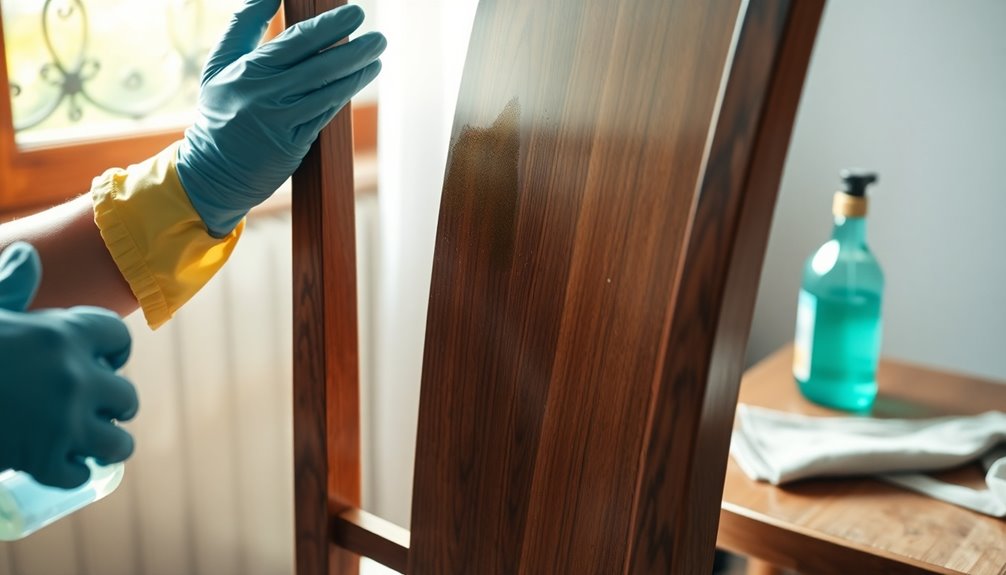
Cleaning wood furniture requires a careful approach to effectively remove mold without damaging the surface. Start by preparing a cleaning solution. Mix equal parts of distilled white vinegar and warm water in a spray bottle. For stubborn mold, use a 3% hydrogen peroxide solution instead. Alternatively, combine one tablespoon of borax with a cup of water or use mild detergent mixed with warm water.
Next, spray your chosen solution onto the moldy areas and let it sit for about 30 minutes to an hour. Dip a soft-bristled brush into the solution and gently scrub the affected areas. After scrubbing, use a clean, damp cloth to wipe away the solution and loosen mold spores, ensuring the cloth isn't overly wet to prevent added moisture. It's important to address any potential sources of excess moisture in the environment to prevent future mold growth.
Thoroughly dry the wood with a soft cloth to eliminate any lingering dampness. To speed up the drying process, allow the wood to air dry in direct sunlight or near a fan. Lastly, vacuum the area with a HEPA filter to remove loose mold spores, disposing of the contents in a tightly sealed plastic bag outside your home.
Preventative Measures
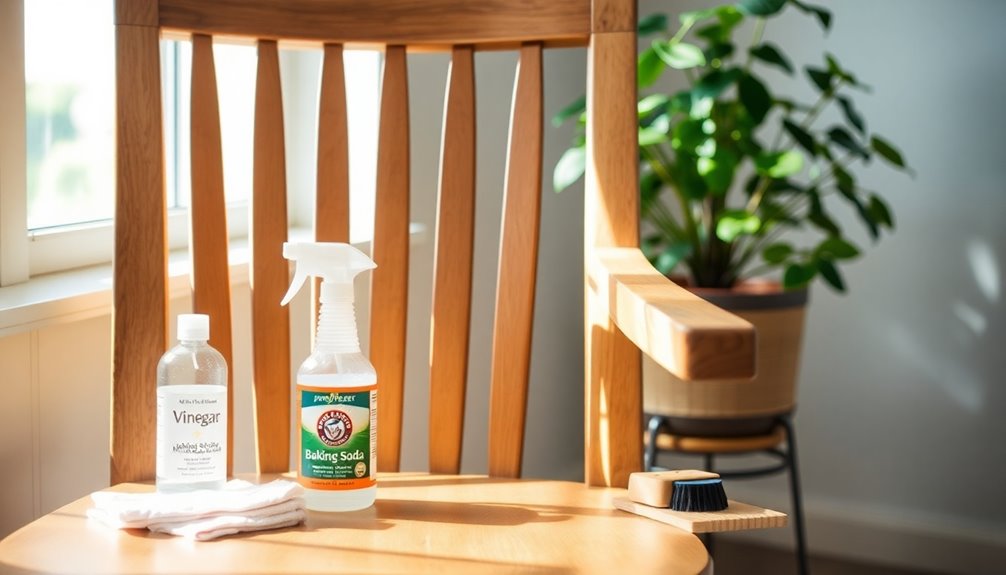
Preventing mold growth on furniture hinges on maintaining a dry and well-ventilated environment. Start by keeping your humidity levels between 30% and 50% using a dehumidifier. Regularly monitor these levels, especially in damp areas like bathrooms and kitchens, and avoid storing furniture in high-humidity spaces. Ensure the storage area is dry and well-ventilated, and consider placing silica gel packets around to absorb excess moisture.
Good air circulation is essential, too. Move your furniture away from walls to allow air to flow freely around it. Use fans to increase circulation, and open windows and doors for fresh air. Position your furniture to receive direct sunlight, which can help dry out any moisture. Maintaining proper air circulation is critical because poor air circulation traps moisture, promoting mould growth.
You should also prevent water damage by checking for leaks and repairing them promptly. Wipe up spills immediately, and dry areas thoroughly after any exposure to water. Regularly inspect your furniture for signs of moisture and mold growth, addressing any issues without delay.
Lastly, maintain your furniture by cleaning it regularly with a dry cloth and applying varnish or sealant to create a moisture barrier.
Final Tips for Mold Control
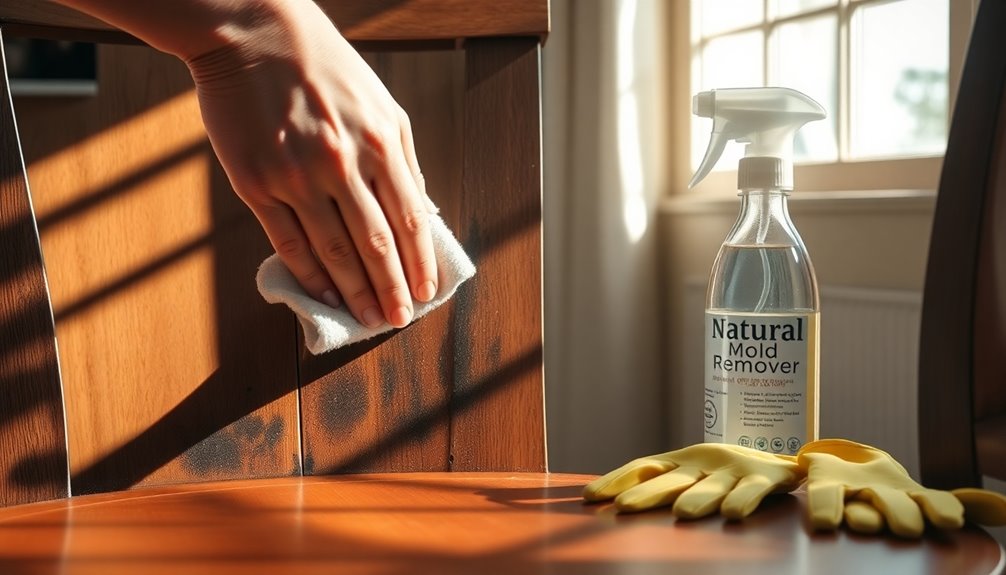
Even with the best preventative measures in place, mold can still find its way onto your furniture. If you discover mold, act quickly. First, isolate the affected furniture by relocating it to a well-ventilated area. Seal off contaminated spaces with plastic sheeting and create negative air pressure to contain the spores. Close all windows and openings to prevent further spreading through your HVAC system.
Once contained, use a brush to loosen mold from surfaces. Apply an EPA-approved biocide or a homemade solution like vinegar or bleach to clean both non-porous and porous items. Rinse thoroughly with clean water and ensure everything is completely dry to prevent future growth. Additionally, be sure to monitor ventilation in the space to minimize mold proliferation.
Dispose of any heavily contaminated materials that can't be cleaned—double-bag these in sturdy plastic. Wear high-grade safety gear when handling moldy items and vacuum the area with a HEPA filter to capture smaller particles.
After cleaning, keep an eye on the area for new growth. Use mold-resistant finishes, maintain a moderate temperature, and keep humidity below 60% with dehumidifiers. Regularly inspect for leaks and address moisture issues promptly to stay mold-free.
Frequently Asked Questions
Can Mold Grow on Leather Furniture?
Yes, mold can definitely grow on leather furniture. If you keep your leather in damp or humid conditions, it creates an ideal environment for mold spores to thrive. The organic composition of leather, along with its moisture retention and porous structure, makes it particularly susceptible. To prevent this, ensure proper ventilation, store your leather in dry areas, and regularly clean it to avoid moisture buildup. Taking these steps can help protect your furniture from mold.
How Can I Tell if Mold Is Dead?
To tell if mold is dead, look for dry, brittle patches instead of fuzzy growth. Check for color changes, like fading or graying, and absence of new colonies. After cleaning, if you notice no regrowth and the musty smell disappears, that's a good sign. Ensure the surface is dry, and watch for reduced allergic reactions. Regular inspections can help confirm mold's gone for good, so stay vigilant.
Is It Safe to Use Essential Oils for Mold Removal?
Using essential oils for mold removal can be safe, but you need to take precautions. Always dilute the oils with water or isopropyl alcohol to protect surfaces. Wear protective gear to avoid inhaling spores, especially during severe infestations. Test a small area first to ensure no damage occurs. Oils like tea tree and clove are effective, but remember, if mold is extensive, it's best to call a professional.
What Should I Do if Mold Returns?
If mold returns, don't panic. First, identify and address the source of moisture, as it's crucial for prevention. Clean the affected area using a mixture of vinegar and water, or a mild antifungal solution. Ensure the furniture dries completely afterward. Boost air circulation by using dehumidifiers and fans. Regularly inspect your furniture for moisture and keep it clean to minimize future mold growth. Stay proactive to protect your belongings!
Can Mold Removal Damage My Furniture Finish?
Yes, mold removal can damage your furniture finish if you're not careful. Using water and harsh cleaners can compromise the finish, especially if it isn't very water-resistant. Even bleach can kill visible mold but leave embedded spores, leading to recurrence. It's best to use mild detergents and test any cleaning solution on a small, inconspicuous area first. Always prioritize gentle methods to protect your furniture's surface while effectively addressing mold issues.
Conclusion
In conclusion, effectively removing mold from your furniture requires quick action and the right approach. By identifying the type of furniture, using appropriate cleaning solutions, and following safety precautions, you can tackle mold issues head-on. Remember to clean both fabric and wood surfaces carefully, and implement preventative measures to avoid future growth. With these tips, you'll keep your furniture mold-free and in great shape for years to come. Don't wait—start your cleaning today!
